 Facebook
Facebook
 X
X
 Instagram
Instagram
 TikTok
TikTok
 Youtube
Youtube
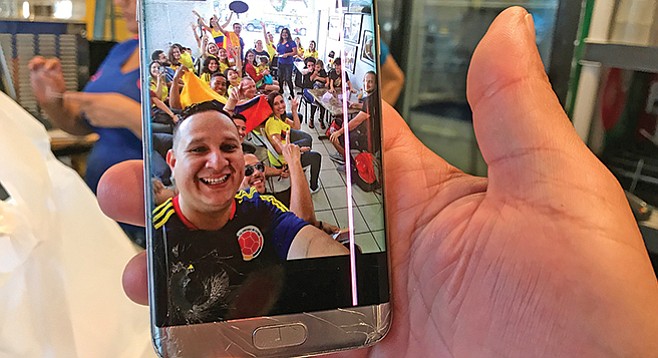
Are we too hung up on spicy? On hot habanero burns to make our eating life sexy?
The question came up the day Colombia beat — no, thrashed — Poland in the World Cup, 3 goals to nil. Every time their guys scored, you’d hear the word ring out. “GO-OAOAOAOA-LLL!!!
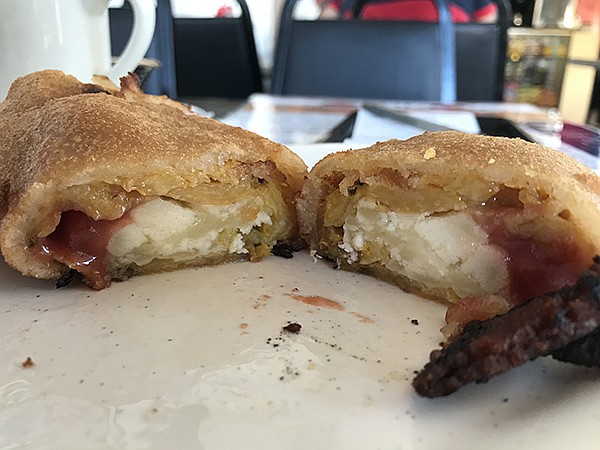
Or so I hear. I’ve come later, around five. This Colombian restaurant has emptied out. People still here look just happily exhausted. “Let me show you why,” says Silvio. He whips out his phone. He calls up pics of the room erupting in craziness the moment Colombia won. “We’ve never been so crowded,” says Andrés, another of the crew.
This is my first Colombian eating experience. At a brightly painted li’l place. Except they’ve joined two shops together, so not so little.
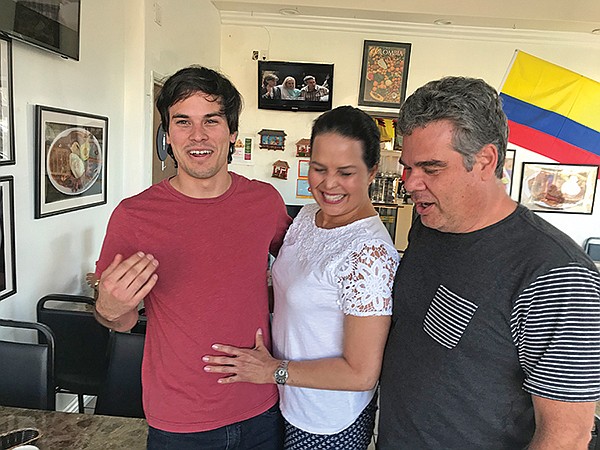
But my question is, what da heck is Colombian food? Like Salvadoran, lots of pupusas? Argentinian? Empanadas? Brazil, black beans?
I’ve heard Colombian food derisively referred to as “ACPM” (Arroz, Carne, Papa, Maduro. Rice, meat, potato, fried plantain) as in, what you’re fed every day in Colombia. Is it the meat and potato capital of South America?
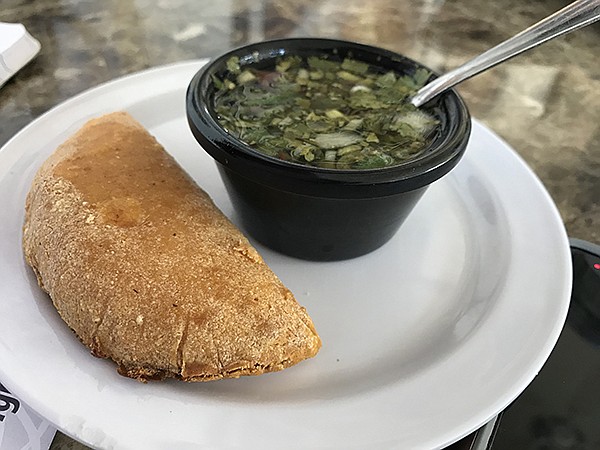
I sit down next to a family of three. Turns out they’re from Venezuela. “Our foods are almost exactly the same as the Colombians’,” says the dad, Andre. “Venezuela is right next to Colombia. So we come here for some home cooking.”
A big yellow, red and blue Colombian flag covers part of one wall. Photos surround it. I notice one features a large oval plate loaded with steak, cut-up pork cracklings, egg, avocado, beans, a kind of white cornmeal patty, and plantain. It looks like a lot for one dish.
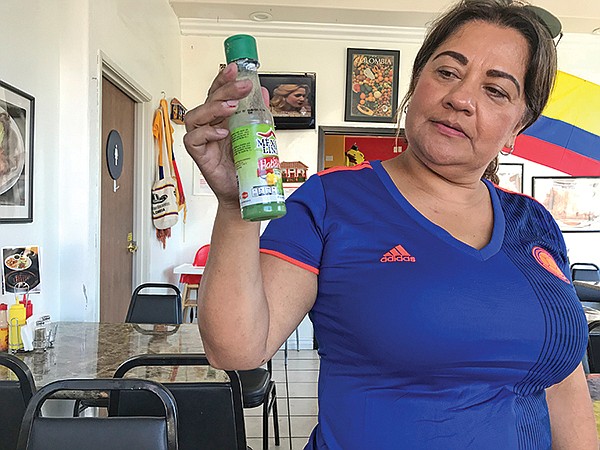
“It’s ‘Bandeja paisa,’” says the guy eating right underneath the photo. Ricardo. He’s from Tijuana. He’s here with his nephew, Héctor. And he’s eating that very dish. “Bandeja Paisa means platter of food from the Paisa area of Colombia. This is different from Mexican food,” he says.. “No spices! But I’m studying to be a chef, so I’m interested in different cuisines.”
“It’s kind of like a national dish,” says Andre. “But you’ve got to be hungry.”
Yeah. My problem: a bandeja goes for $17.50.
This is when Patricia the waitress comes out with big plastic pages in her hand. The menu.
“Tell me about Colombian food,” I say.
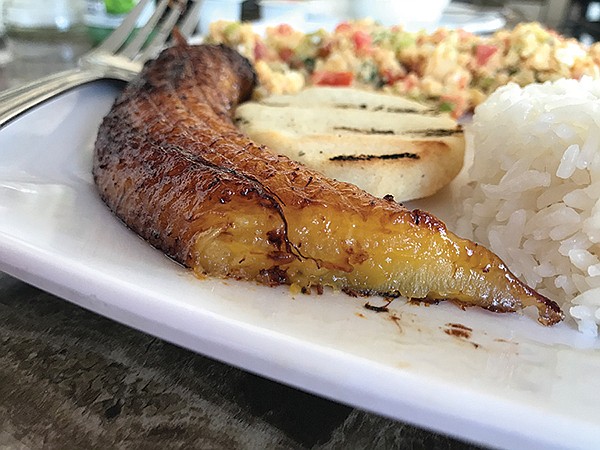
“First off, it’s not hot and spicy,” says Patricia. “Mexican customers are always looking for hot salsas to put on the dishes. That’s not what we do in Colombia.”
Today, that’s fine by me. Fact is, this is the late start to my day. Just need something gentle. And I notice they have a desayuno section.
Top o’ the breakfast list is “Perico.” It’s a combo of scrambled eggs with tomatoes and green onions, served with rice, ripe plantain, and an arepa, basically a cornmeal patty (one of the most ancient food items in the continent, turns out).
“‘Perico’ means ‘parrot’ in Colombia,” says Andres, who works here with Patricia, “but it also means this breakfast, and it also means, uh, cocaine.”
Oh yes, of course. Think “Mis Tres Animales”, by Los Tucanes de Tijuana.
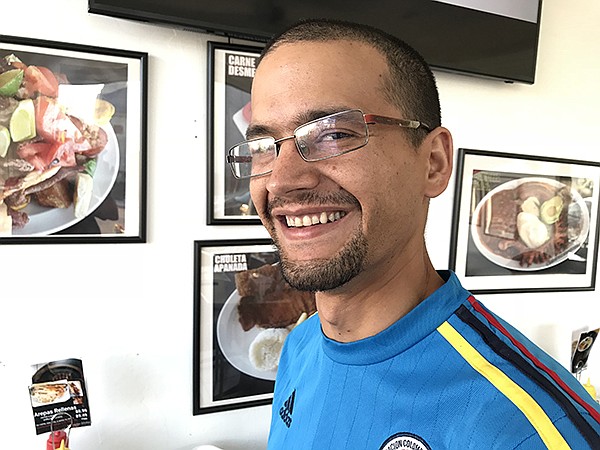
The perico costs $9.99. The three other choices are arepa con carne (a cornmeal patty with steak, $8.50), arepa con chicharron ($8.50), and calentado con carne (rice, beans, plantain, arepa, and choice of meat, $14.99). I order the perico, just before I see other, cheaper possibilities. So, dang it, I order a couple of them, too: an empanada (shredded beef in a deep-fried corn pastry, $1.99), and I ask for a buñuelo, a corn flour fritter with cheese and eggs inside ($1.75). But this morning’s soccer crowd ate them dry, says Andres. So papa rellena (baked potato stuffed with shredded beef and sautéed onions, $4.99), or aborrajado (fried yellow plantain stuffed with cheese, $5). I go for the aborrajado.
Of course, when it all arrives, it’s way too much. But I know it’s gonna last for days. I mean, apart from the arepa and the plantain, the egg brekky looks positively North American. The scrambled egg combo’s gently delicious. Specially with the green onions. The rice is surprisingly unbland, and the plantain has a rich sweetness I didn’t expect. Usually, plantains’re kinda like unsweet bananas. Not this luscious baby. I guess the deep frying brings out the sugars. Even the arepa, the cornmeal patty, which is basically tasteless, is a good filler with the eggs.
So yes, carb city, but it’s the two cheap items that whack me with the best taste surprises. The little empanada has subtle corn tastes, but then when you dip it in the vinegary/parsley aji sauce, it’s a nice little bitey snack. And the aborrajado? It means “battered,” and it’s the deep-fried hit of the day. We’re talking basically sweet plantain, squished corn, of course, but then it has a sweet bocadillo of bright red guava jelly oozing alongside savory cheese, inside the flour and milk pastry wrap.
I mean, there’s no firey flavor in sight, and we’re talking lots of pastry, lots of plantain, lots of corn mush, and deep-fried whatever, but I’m curious now. Want to come back and try their mix of jungle fruits ($5.99), and soups like the sancocho, with its mix of meats and cassava (as well as plantain and potatoes). But you’ve got to be careful, because most dishes run $16 to $20.
Also: do they have traditional Colombian breakfasts of hot chocolate with cheese?
Patricia comes to pick up the one bottle of hot sauce she keeps (Mexico Lindo green habanero salsa), for a table of Mexican customers. I find I haven’t had to use a drop.
The Place: Sabores Colombianos, 3695 University Avenue, City Heights, 619-756-7742
Hours: 11:00am – 8:00pm Sunday to Thursday; till 9pm, Friday and Saturday
Prices: Perico (scrambled eggs, rice, plantain, arepa, cornmeal patty), $9.99; Arepa with chicharron, $8.50; empanada, shredded beef, $1.99; aborrajado (fried plantain, cheese), $5; papa rellena (potato stuffed with beef), $4.99; colita Cubana(ham sandwich, fries), $8.99; chorizo con arepa (pork sausage with cornmeal patty), $3.99; mondongo (beef stock soup with veggies, potatoes), $14.99; bandeja paisa (steak, rice, beans, pork cracklings, $17.50; cazuela de frijoles (bean casserole with pork skin, sausage, beef), $16.99
Buses: 7
Nearest Stop: University at Cherokee (7, eastbound) University at 37th Street (7, westbound)


Are we too hung up on spicy? On hot habanero burns to make our eating life sexy?
The question came up the day Colombia beat — no, thrashed — Poland in the World Cup, 3 goals to nil. Every time their guys scored, you’d hear the word ring out. “GO-OAOAOAOA-LLL!!!

Or so I hear. I’ve come later, around five. This Colombian restaurant has emptied out. People still here look just happily exhausted. “Let me show you why,” says Silvio. He whips out his phone. He calls up pics of the room erupting in craziness the moment Colombia won. “We’ve never been so crowded,” says Andrés, another of the crew.
This is my first Colombian eating experience. At a brightly painted li’l place. Except they’ve joined two shops together, so not so little.

But my question is, what da heck is Colombian food? Like Salvadoran, lots of pupusas? Argentinian? Empanadas? Brazil, black beans?
I’ve heard Colombian food derisively referred to as “ACPM” (Arroz, Carne, Papa, Maduro. Rice, meat, potato, fried plantain) as in, what you’re fed every day in Colombia. Is it the meat and potato capital of South America?

I sit down next to a family of three. Turns out they’re from Venezuela. “Our foods are almost exactly the same as the Colombians’,” says the dad, Andre. “Venezuela is right next to Colombia. So we come here for some home cooking.”
A big yellow, red and blue Colombian flag covers part of one wall. Photos surround it. I notice one features a large oval plate loaded with steak, cut-up pork cracklings, egg, avocado, beans, a kind of white cornmeal patty, and plantain. It looks like a lot for one dish.

“It’s ‘Bandeja paisa,’” says the guy eating right underneath the photo. Ricardo. He’s from Tijuana. He’s here with his nephew, Héctor. And he’s eating that very dish. “Bandeja Paisa means platter of food from the Paisa area of Colombia. This is different from Mexican food,” he says.. “No spices! But I’m studying to be a chef, so I’m interested in different cuisines.”
“It’s kind of like a national dish,” says Andre. “But you’ve got to be hungry.”
Yeah. My problem: a bandeja goes for $17.50.
This is when Patricia the waitress comes out with big plastic pages in her hand. The menu.
“Tell me about Colombian food,” I say.

“First off, it’s not hot and spicy,” says Patricia. “Mexican customers are always looking for hot salsas to put on the dishes. That’s not what we do in Colombia.”
Today, that’s fine by me. Fact is, this is the late start to my day. Just need something gentle. And I notice they have a desayuno section.
Top o’ the breakfast list is “Perico.” It’s a combo of scrambled eggs with tomatoes and green onions, served with rice, ripe plantain, and an arepa, basically a cornmeal patty (one of the most ancient food items in the continent, turns out).
“‘Perico’ means ‘parrot’ in Colombia,” says Andres, who works here with Patricia, “but it also means this breakfast, and it also means, uh, cocaine.”
Oh yes, of course. Think “Mis Tres Animales”, by Los Tucanes de Tijuana.

The perico costs $9.99. The three other choices are arepa con carne (a cornmeal patty with steak, $8.50), arepa con chicharron ($8.50), and calentado con carne (rice, beans, plantain, arepa, and choice of meat, $14.99). I order the perico, just before I see other, cheaper possibilities. So, dang it, I order a couple of them, too: an empanada (shredded beef in a deep-fried corn pastry, $1.99), and I ask for a buñuelo, a corn flour fritter with cheese and eggs inside ($1.75). But this morning’s soccer crowd ate them dry, says Andres. So papa rellena (baked potato stuffed with shredded beef and sautéed onions, $4.99), or aborrajado (fried yellow plantain stuffed with cheese, $5). I go for the aborrajado.
Of course, when it all arrives, it’s way too much. But I know it’s gonna last for days. I mean, apart from the arepa and the plantain, the egg brekky looks positively North American. The scrambled egg combo’s gently delicious. Specially with the green onions. The rice is surprisingly unbland, and the plantain has a rich sweetness I didn’t expect. Usually, plantains’re kinda like unsweet bananas. Not this luscious baby. I guess the deep frying brings out the sugars. Even the arepa, the cornmeal patty, which is basically tasteless, is a good filler with the eggs.
So yes, carb city, but it’s the two cheap items that whack me with the best taste surprises. The little empanada has subtle corn tastes, but then when you dip it in the vinegary/parsley aji sauce, it’s a nice little bitey snack. And the aborrajado? It means “battered,” and it’s the deep-fried hit of the day. We’re talking basically sweet plantain, squished corn, of course, but then it has a sweet bocadillo of bright red guava jelly oozing alongside savory cheese, inside the flour and milk pastry wrap.
I mean, there’s no firey flavor in sight, and we’re talking lots of pastry, lots of plantain, lots of corn mush, and deep-fried whatever, but I’m curious now. Want to come back and try their mix of jungle fruits ($5.99), and soups like the sancocho, with its mix of meats and cassava (as well as plantain and potatoes). But you’ve got to be careful, because most dishes run $16 to $20.
Also: do they have traditional Colombian breakfasts of hot chocolate with cheese?
Patricia comes to pick up the one bottle of hot sauce she keeps (Mexico Lindo green habanero salsa), for a table of Mexican customers. I find I haven’t had to use a drop.
The Place: Sabores Colombianos, 3695 University Avenue, City Heights, 619-756-7742
Hours: 11:00am – 8:00pm Sunday to Thursday; till 9pm, Friday and Saturday
Prices: Perico (scrambled eggs, rice, plantain, arepa, cornmeal patty), $9.99; Arepa with chicharron, $8.50; empanada, shredded beef, $1.99; aborrajado (fried plantain, cheese), $5; papa rellena (potato stuffed with beef), $4.99; colita Cubana(ham sandwich, fries), $8.99; chorizo con arepa (pork sausage with cornmeal patty), $3.99; mondongo (beef stock soup with veggies, potatoes), $14.99; bandeja paisa (steak, rice, beans, pork cracklings, $17.50; cazuela de frijoles (bean casserole with pork skin, sausage, beef), $16.99
Buses: 7
Nearest Stop: University at Cherokee (7, eastbound) University at 37th Street (7, westbound)
Comments